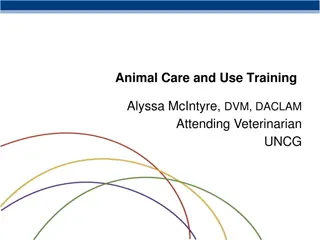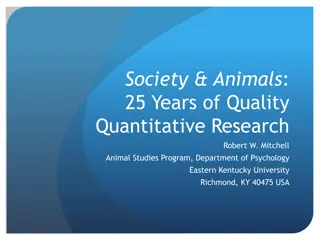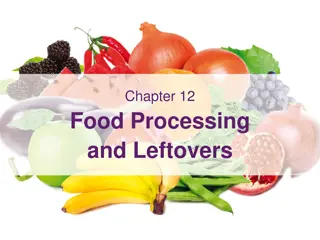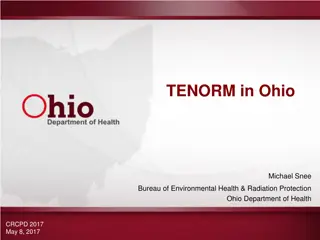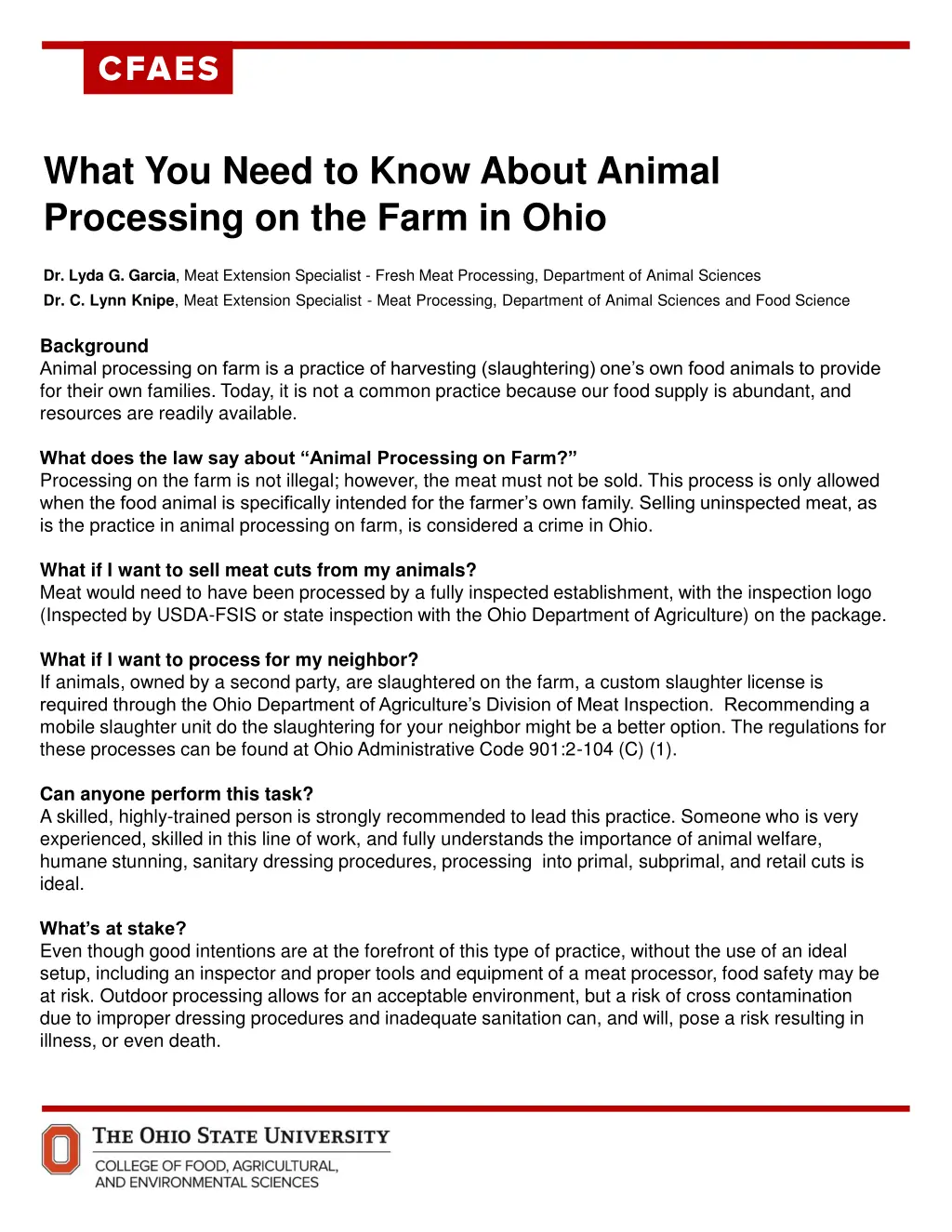
Understanding Animal Processing on Ohio Farms: Regulations & Best Practices
Discover the regulations and best practices for animal processing on farms in Ohio, including legal considerations, health assessments before slaughter, and safety measures to ensure food quality and consumer well-being.
Download Presentation

Please find below an Image/Link to download the presentation.
The content on the website is provided AS IS for your information and personal use only. It may not be sold, licensed, or shared on other websites without obtaining consent from the author. If you encounter any issues during the download, it is possible that the publisher has removed the file from their server.
You are allowed to download the files provided on this website for personal or commercial use, subject to the condition that they are used lawfully. All files are the property of their respective owners.
The content on the website is provided AS IS for your information and personal use only. It may not be sold, licensed, or shared on other websites without obtaining consent from the author.
E N D
Presentation Transcript
What You Need to Know About Animal Processing on the Farm in Ohio Dr. Lyda G. Garcia, Meat Extension Specialist - Fresh Meat Processing, Department of Animal Sciences Dr. C. Lynn Knipe, Meat Extension Specialist - Meat Processing, Department of Animal Sciences and Food Science Background Animal processing on farm is a practice of harvesting (slaughtering) one s own food animals to provide for their own families. Today, it is not a common practice because our food supply is abundant, and resources are readily available. What does the law say about Animal Processing on Farm? Processing on the farm is not illegal; however, the meat must not be sold. This process is only allowed when the food animal is specifically intended for the farmer s own family. Selling uninspected meat, as is the practice in animal processing on farm, is considered a crime in Ohio. What if I want to sell meat cuts from my animals? Meat would need to have been processed by a fully inspected establishment, with the inspection logo (Inspected by USDA-FSIS or state inspection with the Ohio Department of Agriculture) on the package. What if I want to process for my neighbor? If animals, owned by a second party, are slaughtered on the farm, a custom slaughter license is required through the Ohio Department of Agriculture s Division of Meat Inspection. Recommending a mobile slaughter unit do the slaughtering for your neighbor might be a better option. The regulations for these processes can be found at Ohio Administrative Code 901:2-104 (C) (1). Can anyone perform this task? A skilled, highly-trained person is strongly recommended to lead this practice. Someone who is very experienced, skilled in this line of work, and fully understands the importance of animal welfare, humane stunning, sanitary dressing procedures, processing into primal, subprimal, and retail cuts is ideal. What s at stake? Even though good intentions are at the forefront of this type of practice, without the use of an ideal setup, including an inspector and proper tools and equipment of a meat processor, food safety may be at risk. Outdoor processing allows for an acceptable environment, but a risk of cross contamination due to improper dressing procedures and inadequate sanitation can, and will, pose a risk resulting in illness, or even death.
What You Need to Know about Animal Processing on the Farm in Ohio page 2 What should you be looking for before and during the slaughter process to determine that a carcass is safe for consumption? First, does the live animal look healthy? If not, it is not recommended that you slaughter that animal for consumption. The 4D s to consider before slaughter (listed below) would all be condemned in an inspected slaughter plant: Down Disabled Diseased Dead It is important to look for obvious signs of disease on the head, viscera (internal organs) in the main cavity of the body, and the carcass during slaughter, such as: Septicemia (blood poisoning): congestion or inflammation of the lungs, intestines, kidneys, inner surface of the chest or abdominal cavity carcass should be condemned. Abscesses found throughout carcass carcass should be condemned. Jaundiced meat, resulting from cirrhosis of the liver - carcass should be condemned. Enlarged lymph nodes If signs of disease are observed, it is important to have a veterinarian examine the carcass to ensure that the meat is safe for consumption. An on-line document that offers some good pictures can be found at http://beefandlamb.ahdb.org.uk/wp- content/uploads/2018/09/AbattoirGuide_1555_180917_WEB.pdf#page=1 After skinning, evisceration and rinsing with water, it is recommended that the carcass be thoroughly sprayed with a vinegar solution with a clean garden sprayer, to destroy E. coli on beef carcasses and Salmonella on pork carcasses. This vinegar solution is made by diluting commercial vinegar (5% acetic acid) by half with water. Asking your local veterinarian to be on sight for professional answers is recommended. What Bacteria should you be concerned about? Escherichia coli (E. coli) Escherichia coli (E. coli) bacteria normally lives in the intestines of people and animals. Most E. coli are harmless and are an important part of a healthy human intestinal tract. However, some E. coli are pathogenic, meaning they can cause illnesses such as diarrhea or an illness outside of the intestinal tract. The types of E. coli that can cause diarrhea can be transmitted through contaminated water or food, or through contact with animals or persons. E coli O157:H7 is a common pathogen found in feces. Someone consuming e. coli O157:H7 runs a risk of developing hemolytic uremic syndrome (HUS).
What You Need to Know about Animal Processing on the Farm in Ohio page 3 HUS: Around 5 10% of those who are diagnosed with STEC (Shiga toxin-producing Escherichia coli) infection could develop a potentially life-threatening complication known as hemolytic uremic syndrome (HUS). Clues that a person is developing HUS include decreased frequency of urination, feeling very tired, and losing pink color in cheeks and inside the lower eyelids. Persons with HUS should be hospitalized due to the potential for kidney failure and the damage of other organs permanently, and/or they could develop other serious conditions. Most persons with HUS can recover within a few weeks, but some suffer permanent damage or die (Centers for Disease Control and Prevention, 2014). Salmonella: Most people with Salmonella infection suffer from diarrhea, fever, and stomach cramps that can be found in the intestines of humans and animals. Symptoms usually begin six hours to six days after infection and last four to seven days. However, some people do not develop symptoms for several weeks after infection and others experience symptoms after several weeks. Salmonella strains sometimes cause infection in urine, blood, bones, joints, or the nervous system (spinal fluid and brain) and can cause severe disease (Centers for Disease Control and Prevention, 2014). Campylobacter: Campylobacter infection, or campylobacteriosis, is caused by Campylobacter bacteria. It is the most common bacterial cause of diarrheal illness in the United States. People with Campylobacter infection usually have diarrhea (often bloody), fever, and stomach cramps. Nausea and vomiting may accompany the diarrhea. Symptoms usually start two to five days after infection and last about one week. Some people experience complications, such as irritable bowel syndrome, temporary paralysis, and arthritis. Campylobacter can be carried in the intestines, liver, and other organs of animals and can be transferred to other edible parts when an animal is slaughtered. Found in chickens, turkeys, and cows and many other animals. Source: (Centers for Disease Control and Prevention, 2014).. https://www.cdc.gov/ Groups Most at Risk: People with a weakened immune system Adults older than 50, especially with underlying medical issues Infants (children younger than 12 months). Pregnant women Basic Food Safety Measures: Temperature: weather is something that should be accounted for. It is best to find the coolest part of the day to work in. The cooler it is, the slower bacteria will replicate and grow. Bacterial life begins at 40 F. Keep in mind that bacteria associated with this line of work can replicate/grow best between 40 F and 140 F. This temperature range is known as the Danger Zone. The sooner you can place carcasses in a cold environment (ranging between 34 F- 39 F), the less the potential for risk. If refrigerated space is not available to chill the carcass, home butchering should only take place when the outside temperature is below 40 F, until the carcass can be processed and refrigerated or preferably packaged and frozen.
What You Need to Know about Animal Processing on the Farm in Ohio page 4 Basic Food Safety Measures (continued): It is best to remember the 3 C s. Keep it: Cold Covered Clean Equipment/Tools: Knives and handsaws should be washed frequently, between strokes. This will help reduce cross contamination (harvest and processing). Boiling water is recommended for sanitizing knives in during the slaughter process. Water: The use of clean, potable water is critical, as a well a pressured hose to wash carcasses, tools and/or equipment. Carcasses should be rinsed/washed starting from the top, then work downward allowing gravity to work in your favor. Soap: It should be used to wash equipment, tools, and hands. Dawn dishwashing liquid is recommended because it works best on cutting through, cleaning, and removing fat and grease. Aprons: Plastic and rubber material aprons are the best choices; these materials are ideal to wash and rinse. Hands and forearms: Do not cross your dirty hand with your clean hand. Wash hands and forearms frequently, in between steps, to minimize cross contamination. Head Gear: A baseball cap will help reduce hair contamination, especially during the processing step. Tables: should be of nonporous material that is easy to clean. Things to Consider: Disposal of wastewater, inedible parts, and blood Smells attracting pests Noise and smells disturbing neighbors Recommendation for Assistance with Questions: Contacts: Ohio Department of Agriculture Your county health department County cooperative extension office You local veterinarian Disclaimer: This information is intended to inform those thinking about, or involved, in processing animals on the farm. The information provided is intended to present the importance of food safety and risks that come with it. It is not intended to explain the process of dressing procedures, nor promote this type of scenario. Meat processing is complicated, it should not be taken lightly. Person(s) involved should understand that carelessness is not an option with food safety.







